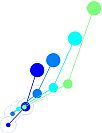Adapting behaviours, an important capacity of living beings, rely on specific brain structures and networks. In our studies we focus on the MidCingulate Cortex (MCC) known to encode reward history and foraging value. The MCC is notably imbedded in 2 networks proposed to be crucial for flexible behaviours. First, a network involving the dlPFC (dorsolateral prefrontal cortex) known to have a key role in regulating behavioural adaptation. Second, a network involving the Locus Coeruleus/ noradrenaline (LC/NA) system suggested to play a role in adaptive gain modulation and the exploration exploitation trade-off. Yet there is a lack of information on whether and how these networks are causally involved in behavioural adaptation.
We modulated two pathways involving the MCC in two groups of macaques (n=2 each) using pathway specific DREADDs (Designer Receptor Exclusively Activated by Designer Drugs) and testing in an homecage foraging task.
First, we targeted the cortico-cortical pathway from MCC to dlPFC. To do so, the floxed genetic material for the hM3Dq DREADD receptor carried by an AAV was injected in the MCC, and the Cre Recombinase carried by canine adenovirus 2 (CAV-2) - a retrograde viral vector – was injected in the dlPFC. Only neurons transfected by both AAV and CAV-2 should express DREADDs.
In the second group we sought to target the noradrenergic Locus Coeruleus (LC) neurons projecting to MCC. Here we injected a single vector into MCC – CAV-2 – but with the hM3Dq DREADD under the PRS promoter that should limit DREADD expression to noradrenergic neurons.
We then tested the pathway-specific excitatory DREADD receptor activation using Deschloroclozapine (DCZ) injected i.m. 30min before behavioural testing. The animals performed a self-organized Spatial Foraging task (SFT25-50), with which one can evaluate patterns of foraging choices, decisions and spatial exploratory behaviour.
We present results showing the differential effects of the DREADDs activation in these 2 groups on engagement in the foraging task and on regulating decisions based on outcomes. We also present histological analyses validating the pathway-specific transfection.

 PDF version
PDF version
